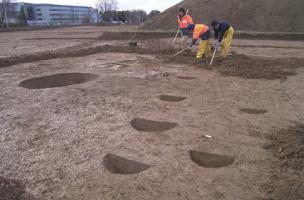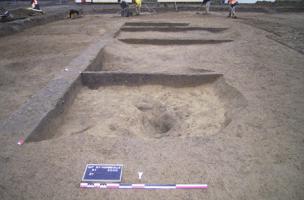Search
You are here
A Gaulois village discovered at Gif-sur-Yvette
A team from the Institut national des recherches archéologiques préventives (Inrap) has made an important find at Gif-sur-Yvette: the remains of a village dating from the late 6th – early 5th century B.C., unparalleled in the north of France.
Post date
23 February 2006
Last modified
10 February 2017
The Greater Saclay Authority (CAPS), wishing to improve its knowledge of the local heritage, asked the DRAC - Regional Archaeology Service to undertake an archaeological evaluation, to be followed, if necessary by full excavation.
Twelve Inrap archaeologists, directed by Olivier Blin, have been excavating 3 hectares since November 2005. They have found a settlement dating mainly from the end of the First Iron Age (Hallstatt) characterised by plots of land each enclosed by small shallow ditches.
In each area can be found dwellings, silos, granaries and other practical constructions. Sunken featured buildings have yielded numerous spindle-whorls whose presence indicates weaving. Abundant archaeological finds (ceramic vases for cooking or storage, some decorated or painted, bronze fibulae …) have been found in backfilled pits. The examination of the numerous animal bones will give an idea about the eating habits of the time. The work of palaeo-botanists will help us to grasp the environmental conditions, to identify the different crops grown, and to imagine the landscape.
In the western part of the site, an area enclosed by a ditch, dating from the same period, probably had a building at its centre. This would be the residence of someone of high rank.
What has been found is a "Gaulois village", a major discovery for the North of France. It is to be compared with the strongholds and princely dwellings known in the East and the South of France.
Twelve Inrap archaeologists, directed by Olivier Blin, have been excavating 3 hectares since November 2005. They have found a settlement dating mainly from the end of the First Iron Age (Hallstatt) characterised by plots of land each enclosed by small shallow ditches.
In each area can be found dwellings, silos, granaries and other practical constructions. Sunken featured buildings have yielded numerous spindle-whorls whose presence indicates weaving. Abundant archaeological finds (ceramic vases for cooking or storage, some decorated or painted, bronze fibulae …) have been found in backfilled pits. The examination of the numerous animal bones will give an idea about the eating habits of the time. The work of palaeo-botanists will help us to grasp the environmental conditions, to identify the different crops grown, and to imagine the landscape.
In the western part of the site, an area enclosed by a ditch, dating from the same period, probably had a building at its centre. This would be the residence of someone of high rank.
What has been found is a "Gaulois village", a major discovery for the North of France. It is to be compared with the strongholds and princely dwellings known in the East and the South of France.
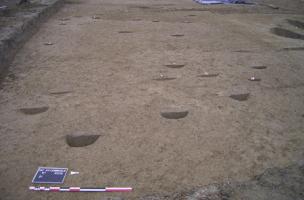
Ensemble de fosse d'extraction de limon destiné aux construction (torchis) (Fin du Ier âge du fer).
© O. Blin/Inrap.fr

Vestiges d'un sol avec foyer d'un bâtiment excavé du Ier âge du fer.
© O. Blin/Inrap.fr
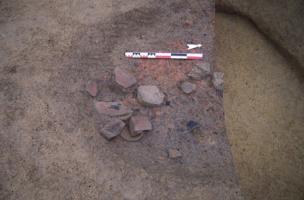
Fosse avec rejets de céramiques et résidu de foyer (Fin premier âge du Fer).
© O. Blin/Inrap.fr
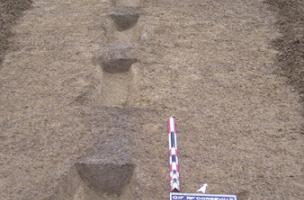
Petit fossé de drainage ou de parcellaire.
© O. Blin/Inrap.fr
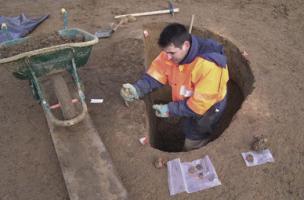
Fouille d'une fosse à rejets domestiques ayant peut-être servi de silo à l'origine.
© O. Blin/Inrap.fr
Site Director : Olivier Blin, Inrap
Curation : Regional Archaeology Service (Drac Île de France)
Developers : Communauté d'Agglomération du Plateau de Saclay (CAPS)
Contact(s) :
Mahaut Tyrrell
Media communication
Inrap, media partnerships and relations
+33 6 07 40 59 77
mahaut.tyrrell [at] inrap.fr


